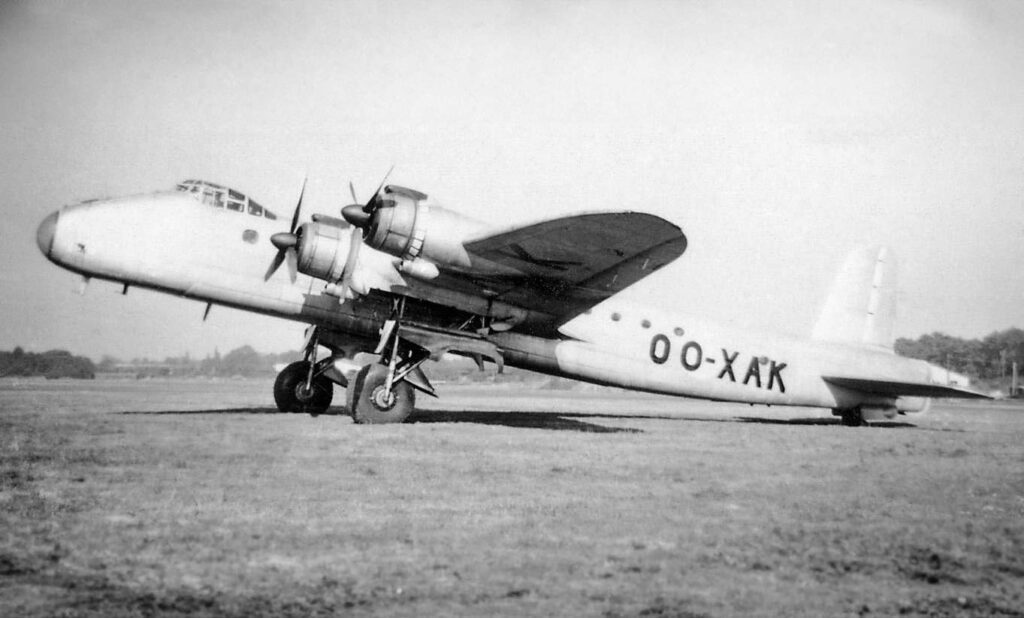The Short Stirling, Britain’s first four-engine heavy bomber of WWII, known for its large payload capacity and distinctive wing design.
This article provides a detailed examination of the Short Stirling, the first four-engine heavy bomber used by the British Royal Air Force (RAF) during World War II. It discusses the historical context of its development, design features, performance metrics, and military usage. The history section outlines the strategic requirements that led to its development, including its first flight and design objectives. The design portion highlights its technical specifications, advantages, and drawbacks. The performance segment compares the Stirling with other contemporary bombers, emphasizing its capabilities and limitations. Finally, the military use section details its combat roles, operational history, and eventual replacement, offering a comprehensive view of this significant aircraft.
The Short Stirling was a cornerstone of British air power during World War II, serving as the RAF’s first heavy bomber. Its development marked a significant leap in bomber aircraft technology and played a crucial role in Allied bombing campaigns.
History of the Development of the Short Stirling
In the late 1930s, as Europe edged closer to war, the RAF identified a need for a new class of heavy bombers. This requirement led to the initiation of the Short Stirling program by Short Brothers, under the leadership of chief designer Arthur Gouge. The primary goal was to create a bomber with greater payload capacity, range, and defensive capabilities than existing models.
The program was launched amid the backdrop of escalating military tensions and the evolving theory of strategic bombing, which emphasized the need to attack enemy industrial and civilian targets. The Stirling represented a strategic shift towards these objectives.
The Short Stirling first flew on May 14, 1939. Its development was marked by challenges, including restrictions imposed by existing airfield sizes, which influenced its design.
Design of the Short Stirling
The Short Stirling was distinguished by its unique design, featuring a high wing and four powerful Bristol Hercules engines. It had a wingspan of 99 feet 1 inch (30.2 meters) and a length of 87 feet 3 inches (26.6 meters). Its design was constrained by the Air Ministry’s specification that bombers must fit within existing hangars, resulting in a wing span shorter than its contemporaries. This limitation impacted its overall performance, particularly its ceiling and range.
The Stirling’s construction utilized extensive aluminum and magnesium alloys, which allowed for a maximum takeoff weight of approximately 70,000 pounds (31,751 kilograms). Its defensive armament included multiple .303 inch machine guns positioned in the tail, dorsal, and nose turrets.
Despite its innovative design, the Stirling faced limitations due to its relatively short wingspan. While this design provided certain advantages in handling and takeoff, it limited the aircraft’s service ceiling and payload compared to larger-winged contemporaries.

Performance of the Short Stirling
Powered by four Bristol Hercules XVI radial engines, each producing 1,615 horsepower (1,204 kW), the Stirling had a maximum speed of around 282 mph (454 km/h) and a service ceiling of just over 16,000 feet (4,877 meters). Its operational range was about 2,330 miles (3,750 kilometers) with a reduced bomb load.
When compared to other heavy bombers like the Avro Lancaster and the Boeing B-17 Flying Fortress, the Stirling had a lower operational ceiling and payload capacity. However, its sturdy design and good low-altitude performance made it reliable for various operations.
Military Use and Combat of the Short Stirling
The Stirling was initially used for strategic bombing missions over Germany, carrying a bomb load of up to 14,000 pounds (6,350 kilograms). Its armament included a mix of general-purpose bombs, incendiaries, and later, specialized munitions like the “Blockbuster” bombs.
During its service, the Stirling participated in significant bombing campaigns, including the Battle of the Ruhr and the bombing of Berlin. However, its lower service ceiling made it more vulnerable to anti-aircraft fire and enemy fighters, leading to high casualty rates.
The Stirling faced competition from newer bombers like the Lancaster and the Halifax, which eventually surpassed it in performance. By 1943, it was increasingly relegated to secondary roles, such as glider towing, supply dropping, and electronic warfare.
The aircraft was not extensively exported and was gradually phased out of frontline service by the end of the war. It was ultimately replaced by more advanced bombers with higher ceilings and greater payloads.
The Short Stirling played a pivotal role in the RAF’s early wartime bombing campaigns, marking a significant development in British aviation technology. Despite its limitations, the Stirling was a critical step in the evolution of heavy bombers, laying the groundwork for more advanced designs that followed. Its contribution to the Allied war effort, particularly in the early years of World War II, underscores its importance in the history of military aviation.
Back to the Bombers section.